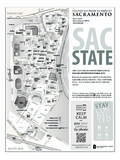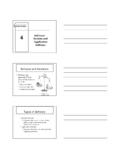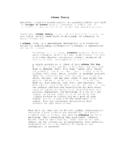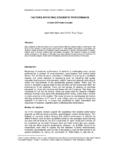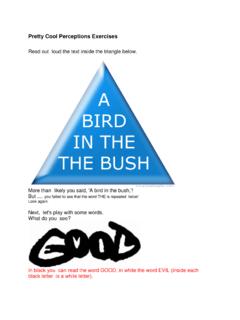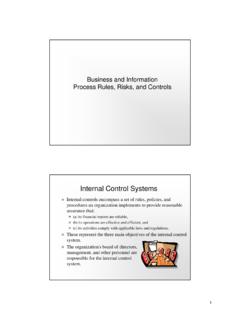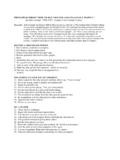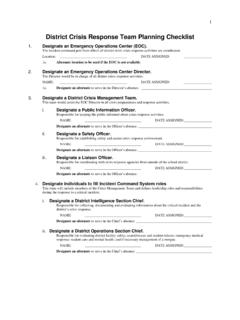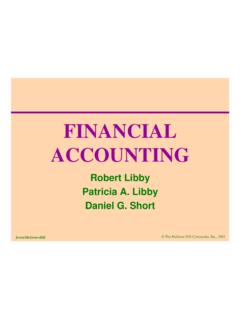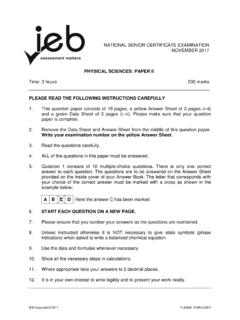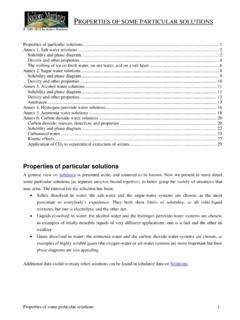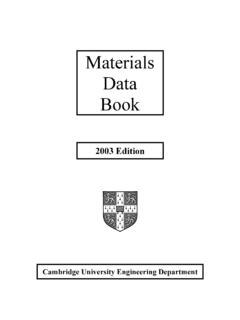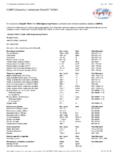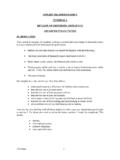Transcription of Types of Organic ReactionsTypes of Organic Reactions
1 Types of Organic ReactionsTypes of Organic Reactions1. Addition Reactions : A+B C1. Addition Reactions : A B CHOOHOO+ H2 OHOOHOOOHOO fumaratemalate2. Elimination Reactions : D E + FHOOHOO+ H2 HOOHOO succinatefumarate3. Substitution Reactions : G-H + I G-I + HOOOO1 HOO+ SCoAHOOa-ketoglutaratesuccinyl CoAOHSCoA+ OHTypes of Organic ReactionsTypes of Organic Reactions4. Rearrangements: J K4. Rearrangements: J KHOOHOOiiiOHOOHOOHCO2 HCO2 HOHcitrateisocitrateHow do these Reactions occur?Why do these Reactions occur?Why do these Reactions occur?We must explain how electrons are exchanged during the formation ofnew bonds and breaking of old bondsnew bonds and breaking of old Reactions OccurHow Reactions OccurSymmetrical Bond Making/Breaking (homolytic process)Symmetrical Bond Making/Breaking (homolytic process)vsUnsymmetrical Bond Making/Breaking (heterolytic process) - POLAR Reactions3 Indicating Electron Movement in ihiReaction Mechanisms Curved arrows indicate breaking and forming of bonds Arrowheads with a half head ( fish-hook ) indicate homolytic and homogenic steps (called radical processes ) Arrowheads with a complete head indicate heterolytic and heterogenic steps (called polar processes ) 4 Polar ReactionsPolar ReactionsOpposite charges attract Nucleophiles (electron rich sites, seek nucleus)
2 - have lone pair of electrons or C=C bondOOHHOHClNH2O Electrophiles (electron poor sites, seek electrons) - have formal positive charge or partial positive charge via bond dipoleNucleophiles are synonymous with Lewis BasesElectrophiles5 Nucleophiles are synonymous with Lewis Bases, Electrophilesare synonymous with Lewis Acids, Polar Reactions are Lewis Acid-Base and ElectrophilesNucleophiles and ElectrophilesNote that compounds can be nucleophilic and electrophilic. You must look at specific atoms and what the compound is reacting with to determine how it will react:OHOHOHOHOS trong Nucless stable anionStrong E+less stable cationJudging relative 'strengths' of Nuc and E+less stable anionmore stable anionlone pair less EN atomlone pair more EN atomless stable cationmore stable cationneutral atom incomplete octetlarge partial positive atom7C=CWeak Nucsmall partial positive atomWeak E+Drawing Reaction MechanismsDrawing Reaction MechanismsUse of curved arrows to show electron movement in bond making and bond breaking process.
3 For polar Reactions , electrons move as a pair. Note that charges must also balance. Thfthlhilitiit t thl thili The arrow goes from the nucleophilic reaction site to the electrophilic reaction site The nucleophilic site can be neutral or negatively charged8 Drawing Reaction MechanismsDrawing Reaction Mechanisms The electrophilic site can be neutral or positively chargedhlbflld The octet rule must be followed9 (never have +2 or -2 charge on a single atom)Drawing Reaction MechanismsDrawing Reaction Mechanisms+O+O+10Br+Drawing Reaction MechanismsDrawing Reaction Mechanisms+O+OOOOBr+O+ Br11An Example of a Polar Reaction: ddi ifh lAddition of HBr to Ethylene HBr adds to the part of C-C double bondp The bond is electron-rich, allowing it to function as a nucleophile H-Br is electron deficient at the H since Br is much more electronegative, making HBr an electrophile12 Mechanism of Addition of HBr to hlEthylene13 Why Reactions OccurWhy Reactions OccurAll Organic Reactions we will study will reach equilibrium that favors thegyqmore stable side.
4 In most cases, these will be reaction products as writtenfrom left to right (note, however, sometimes you must predict which side is favored as in acid-base Reactions ). G = -RTln Keq= H - T SIf Keq > 1, energy is released to the surroundings (exergonicreaction, negative value of G , reaction favored)If Keq < 1, energy is absorbed from the surroundings eq, e e gy s abso bed oe su ou d gs(endergonicreaction, positive value of G , reaction not favored)Energy changes in a reaction are illustrated by Energy Diagrams14 Energy changes in a reaction are illustrated by Energy DiagramsReaction Energy DiagramsReaction Energy DiagramsOne Step Reactions :pExergonic (- G)(thfd)Endergonic (+ G)(tht fd)15(thermo favored)(thermo not favored)Reaction Energy DiagramsReaction Energy DiagramsMultiple Step Reactions :pp16 Reaction Energy DiagramsReaction Energy Diagrams The highest energy point ggypin a reaction step is called the transition state Thd d t The energy needed to go from reactant to transition state is the activation energy ( G )HCCHHBr 17 HHReaction Energy DiagramsReaction Energy Diagrams If a reaction occurs in more hiilthan one step, it must involve species that are neither the reactant nor the final productThll dti These are called reaction intermediatesor simply intermediates Ehh if Each step has its own free energy of activation The complete diagram for the tihth freaction shows the free energy changes associated with an intermediate18 Estimating G from HEstimating G from H H=(energy needed to break bonds)-(energy released when bonds form) H (energy needed to break bonds) (energy released when bonds form)
5 Bonds BreakingC=C = 611 kJ/molHB366 kJ/lBonds FormingC-C = 355 kJ/molCB285 kJ/lH-Br = 366 kJ/molC-Br = 285 kJ/molC-H = 420 kJ/mol H(977 kJ/l)(1060 kJ/l)83 kJ/l (thi )19 H = (977 kJ/mol) -(1060 kJ/mol) = -83 kJ/mol (exothermic)202122 Are the following Reactions hd illf dthermodynamically favored?+O+OOOOBr+O+ Br23
